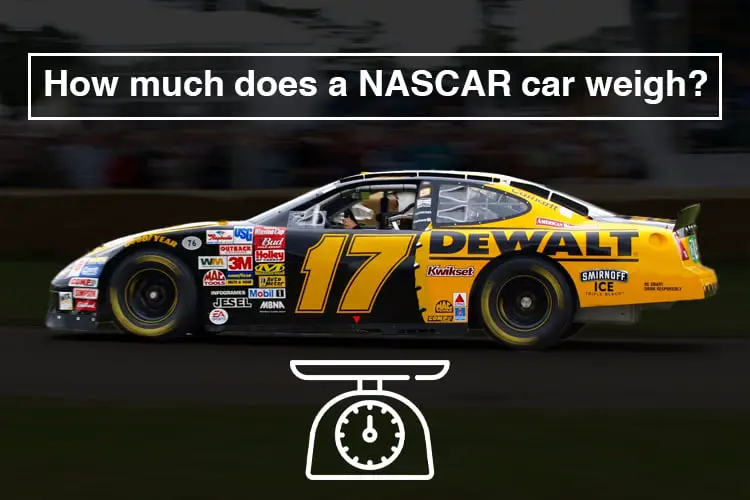Last Updated on January 29, 2024 by Pittalks
In the world of motorsport, NASCAR stands out for its meticulous regulations on car specifications, including a critical aspect like vehicle weight. The weight of the car is a fundamental factor not only in ensuring compliance with the rules but also in affecting the dynamics of the race. It is a delicate balance; too heavy, and the car loses speed and agility, too light, it may not handle as well, particularly around the sharp turns of a racetrack.
The concept that weight can be both an advantage and a disadvantage is particularly intriguing in NASCAR. Engineers and drivers work together to harness the physics of weight distribution to their benefit. By achieving the optimal weight, teams aim to enhance downforce, which is crucial for maintaining speed in corners without compromising the overall performance on the straights. Understanding the weight of a NASCAR vehicle is essential, as it dictates this balance and ultimately contributes to a driver’s success on the track.
How much a NASCAR Cup car weighs
In NASCAR Cup Series racing, precision in weight specifications plays a critical role in maintaining competition equanimity. The NASCAR rule book mandates that race cars meet the following weight criteria:
- Minimum Weight Without Fuel or Driver: Race cars are required to weigh at least 3,300 pounds (1,496 kilograms).
- Driver Weight Consideration: The standard driver weight assumed by NASCAR is 180 pounds. Any driver weighing less must compensate by adding weight to their vehicle to align with this benchmark.
Consider the case of Kyle Larson, a professional driver. His lighter frame at 135 pounds necessitates the addition of 50 pounds to the vehicle to meet the regulatory weight.
Table: Driver Weight Adjustments
| Driver | Actual Weight | Additional Weight Added |
|---|---|---|
| Kyle Larson | 135 lbs | +50 lbs |
| Danica Patrick (2013) | 110 lbs | +40 lbs |
- Fuel Weight: The total weight of the car increases further when accounting for fuel. With racing fuel weighing 6 pounds per gallon and a maximum fuel capacity of 22 gallons, a NASCAR Cup car carries an additional 132 pounds of fuel weight.
When these elements are combined, they yield the total weight specification for a race-ready NASCAR Cup car:
- Total Weight (with Driver and Fuel): The cumulative weight of a NASCAR Cup car inclusive of fuel and a driver averaging 180 pounds approximates to 3,612 pounds (1,638 kilograms).
These weight regulations are assiduously adhered to by teams to ensure their vehicles comply with the critical standards set forth by NASCAR officials, which are designed to uphold the integrity of the sport.
How much a NASCAR tire and wheel weigh
- NASCAR Tire: 24 lbs (18” diameter)
- NASCAR Wheel: 27 lbs
- Combined Weight: 51 lbs
During pit stops, a tire carrier handles a considerable load, typically two tires for a total of 101 lbs. Tire carriers must maneuver this weight swiftly, showcasing the demanding nature of their role. Learn More
How much the engine weighs in a NASCAR car
- Engine Type: V8
- Displacement: 358 cubic inches (5.9-liter)
- Horsepower: Approximately 700-800
- Engine Weight: 575 lb (260 kg) without oil
- Percentage of Car Weight: Over 17%
NASCAR car engines are significant in weight and power, influencing fuel management strategies during racing, given their fuel capacity and consumption rates.
NASCAR weight distribution – How important is it?
Weight distribution in NASCAR vehicles is a vital factor that significantly influences a car’s handling and performance during races. Achieving the optimal weight balance is crucial for the various challenges presented by different types of tracks.
- Oval Tracks:
- Weight is biased towards the left (up to 58%), enhancing speed and stability through left-hand turns.
- Front weight bias is around 52%, improving grip on the front tires.
- Road Courses:
- A more equitable weight distribution, closer to 50/50, is needed due to the mixture of left and right turns.
- The preference for rear weight bias increases braking power and acceleration.
During an oval NASCAR race, strategic left-side weighting allows cars to navigate turns with greater agility and velocity. Conversely, for road courses, where the direction of turns varies, maintaining an evenly balanced weight distribution becomes essential for optimal control and maneuverability.
Adjustments to weight balance, including shifting weight between the front and rear axle, can be made using various tools and techniques. One such method involves the use of a track bar, which crews can adjust to fine-tune a car’s weight distribution according to the track’s demands.
For an insight into the technical procedures of weight adjustment in NASCAR, the provided video offers a detailed explanation of how pit crews utilize a track bar: NASCAR® Track Bar Weight Distribution – Snap-on Tech Series: Penske® Edition ft. Brad Keselowski
Correct weight distribution is not just a matter of compliance with regulations—it is about precise control, efficiency in maneuvering, and the competitive edge that can lead to victory in NASCAR races.
How much does a NASCAR truck weigh?
- Series: NASCAR Camping World Truck
- Minimum Weight: 3,400 lbs (without driver and fuel)
- Engine: Comparable in horsepower to other NASCAR series
- Performance: Slightly slower due to design
NASCAR trucks are designed to be heavier, with a minimum weight set at 3,400 pounds, yet they can still generate a significant amount of horsepower. Their performance on the track is impacted by their design, which is less aerodynamic than the other NASCAR series vehicles. Despite the additional weight, NASCAR trucks demonstrate a remarkable combination of power and agility in the racing world.
In conclusion
NASCAR CUP cars are engineered with precision, mindful of the significance of weight. At a minimum of 3,300 pounds, these vehicles integrate advanced safety systems and essential race gear while optimizing for performance. Weight plays a pivotal role in the high-stakes arena of racing, where strategic balance is key.
Let me know what you think about this number in the comment section below.
Frequently Asked Questions
What is the weight range for NASCAR Cup series cars?
The NASCAR Cup series cars have a set minimum weight requirement:
- Without driver and fuel: 3,300 pounds (1,451 kilograms)
- With driver and fuel: 3,400 pounds (1,542 kilograms)
How does the weight of a NASCAR vehicle compare to that of a Formula 1 cars?
When comparing weights:
- NASCAR Cup car: Averages about 3,300 pounds without driver and fuel.
- Formula 1 car: Typically weighs around 1,543 pounds (700 kilograms), including driver but not fuel.
What are the horsepower specifications for a NASCAR Cup car?
NASCAR Cup cars are powerful, with their engine specifications as follows:
- Engine: 358 cubic inches (5.9-liter) V8
- Horsepower: Approximately 700 to 800 HP
How has the weight of NASCAR cars changed with the introduction of the Gen 7 model?
With the introduction of the Gen 7 car:
- The weight distribution and safety features have been optimized.
- Exact changes in overall weight have not been specified, but efforts have been made to enhance performance and safety.
References:


